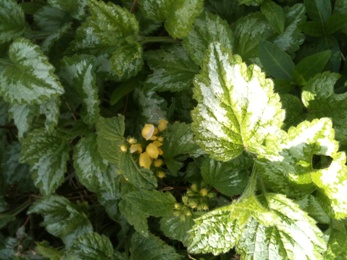— by Kate Yturri, Judy Winer and Gwen Stamm, updated April 17 at 10 p.m. —
Yellow Archangel (Lamiastrum galeobdolon) is an attractive ornamental ground cover found in San Juan County. It is classified as a Class B noxious weed in Washington State, and control is required county-wide.
It is a noxious weed because it easily becomes invasive, forming dense patches that out-compete native plant species and provides little or no food or shelter for native wildlife. Yellow archangel groundcover has escaped gardens to naturalize in county forestlands and has taken over the county park’s Eagle Cove streambed. Once established, it is exceedingly difficult to control.
Often growing in shade, it can be recognized by its variegated, silver-gray colored oval-shaped leaves that are toothed. Yellow archangel is a member of the mint family, and thus has stems that are square in cross section, with leaves arranged in opposite pairs. It is an evergreen to semi-evergreen fast-growing perennial that propagates by seed and from nodes on stems and can be either trailing or upright.
In April through June its stems are covered with attractive yellow flowers that are small and tubular. It closely resembles Spotted Dead Nettle (Lamium maculatum), which has pink, purple or white flowers.
The most important way to control Yellow Archangel is not to plant it. Discourage nurseries from selling it and dispose of it responsibly. Yellow Archangel can be
removed mechanically by hand pulling or digging out the plant, starting at the outer edge of the infestation and working toward the middle. Remove as much of the plant as possible since any fragments left behind will re-sprout. Mowing or cutting alone does not control this plant. Sheet mulching is effective but will also kill
desired plants.
Plant remains should be disposed of by placing them into a black garbage bag in your garbage or by allowing the material to rot in the bag. Placing the plant parts on
a tarp and allowing them to desiccate in the sun will also work. Never discard the plants or their parts in your compost, in the woods or near a wetland or stream!
After removal plant the area with natives or other desirable plants. Please contact the San Juan County Noxious Weed Program at 376-3499 for further information.
Kate Yturri, Judy Winer and Gwen Stamm are 2013 graduates of the WSU Master Gardener’s Course.
**If you are reading theOrcasonian for free, thank your fellow islanders. If you would like to support theOrcasonian CLICK HERE to set your modestly-priced, voluntary subscription. Otherwise, no worries; we’re happy to share with you.**









As you look for, and eradicate Yellow Archangel (how…please tell us), take your weed wrench and pull the healthy, dark green clumps of Scotch Broom. The plants are easy to spot because of their deep green color, and small leaves lining the shoots. Weed wrenches can be borrowed from the Noxious Weed office in the Senior Center.
Yellow blossoms are coming out already on the Scotch Broom…get out there, quick.
You can remove this plant with a digging tool or hand shovel starting at the outer boundary of the infestation and moving to the center. Now while the ground is moist you can carefully dig and pull the plants up leaving no plant parts. Replant the area with natives such as: native bleeding heart (Dicentra formosa) or any of the other Dicentra species, Bishop’s Hat (Epimedium spp.), Kinnikinnick (Arctostaphylos uva-ursi), coralbells (Heuchera and Heucherella spp.), wild strawberry (Fragaria chiloensis), native wood sorrel (Oxalis oregana), Solomon’s Seal (Polygonatum spp., Maianthemum spp.) or ferns.